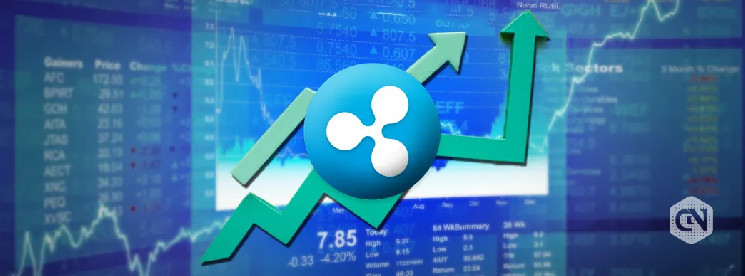The final quarter of 2024 witnessed a dramatic resurgence in XRP’s market performance, marked by a remarkable 280% price surge. This impressive rebound, as detailed in Ripple’s Q4 XRP Markets Report, can be attributed to a confluence of factors, primarily the easing of regulatory pressures and a renewed sense of investor confidence. The report highlights the significant impact of the previously uncertain regulatory landscape, which had dampened market activity and suppressed XRP’s potential, particularly given its historical standing as the second-largest digital asset prior to the SEC lawsuit. As these uncertainties began to dissipate, trading volume exploded, reaffirming the underlying demand for XRP and its utility within the digital asset ecosystem. Binance, Upbit Korea, and Coinbase emerged as the leading exchanges for XRP spot trading, accounting for significant portions of the overall volume. Notably, U.S. demand experienced a significant uptick following the presidential election, reflected in the doubling of Coinbase’s XRP trading share, indicating a renewed interest from American investors.
The resurgence of XRP trading activity manifested in substantial volume increases across all exchanges. Ripple’s report indicates that average daily spot trading volumes surged to $5 billion from mid-November through December, peaking at a remarkable $25 billion on December 2nd. This surge in trading activity underscores the renewed confidence in XRP’s market prospects, driven by a more favorable regulatory environment and a growing recognition of its potential within the evolving digital asset landscape. The increase in volume wasn’t confined to retail investors; institutional players also demonstrated increased engagement with XRP, further solidifying its position within the broader financial ecosystem. This institutional interest manifested in concrete actions, with several prominent firms, including WisdomTree and Coinshares, submitting applications for spot XRP exchange-traded funds (ETFs), joining existing applicants like Bitwise, Canary Capital, and 21Shares in seeking SEC approval.
A significant driver of this positive momentum was the evolving regulatory landscape, particularly within the United States. Ripple’s report emphasized the shift in approach by the new administration, which signaled a more open and supportive stance towards digital assets. President Trump’s executive order recognizing the role of digital assets in the economy was a key turning point, emphasizing the need for regulatory clarity through comprehensive legislation and promoting innovation in the stablecoin sector, particularly those backed by U.S. Treasuries. The establishment of a Working Group dedicated to digital asset markets further reinforced the administration’s commitment to fostering responsible innovation within the sector. These developments created a more conducive environment for digital assets like XRP, encouraging investment and fostering broader adoption.
Adding to the positive regulatory developments, the SEC experienced significant leadership changes, with Chairman Gary Gensler’s resignation and subsequent replacement by Acting Chairman Uyeda. Uyeda’s critical stance on past regulatory actions, particularly those that created confusion and stifled innovation, signaled a potential shift in the SEC’s approach. The rescission of SAB 121, a policy widely criticized by the industry, further underscored the changing regulatory tide. While Ripple’s ongoing legal battle with the SEC continued, the broader regulatory shifts provided a more optimistic backdrop for the company and the XRP ecosystem. The SEC’s appeal filing in January, reiterating previously rejected arguments, was met with opposition from Ripple due to its timing, particularly considering upcoming leadership changes within the SEC. The ongoing legal proceedings, however, did not overshadow the positive momentum generated by the broader regulatory shifts.
Beyond the price action and regulatory developments, the XRP Ledger (XRPL) also experienced significant growth in Q4 2024. A surge in new wallet creation, a 404% increase to 709,545, indicated growing user adoption and engagement with the XRPL. This growth was accompanied by a 22% increase in XRP burned in transaction fees, further demonstrating the increased activity on the network. Decentralized exchange (DEX) trading volume on the XRPL also exploded, reaching $1 billion, largely driven by the introduction of Automated Market Makers (AMMs), which enhanced liquidity and facilitated more efficient trading. These developments underscore the growing utility and adoption of the XRPL as a platform for various decentralized finance (DeFi) applications.
Further solidifying the XRPL’s expanding ecosystem, Ripple announced progress in stablecoin adoption, with RLUSD integrating into multiple exchanges and payment providers. The emphasis on RLUSD’s potential to streamline cross-border payments and facilitate real-world asset tokenization highlighted its practical applications within the evolving financial landscape. Institutional adoption of tokenization on the XRPL also gained momentum, with partnerships like Archax and abrdn tokenizing money market funds, and Societe Generale-FORGE (SG-FORGE) planning to introduce its stablecoin, EURCV, to the XRP Ledger. These developments demonstrate the growing recognition of the XRPL’s capabilities and its potential to transform traditional financial processes. The confluence of positive regulatory shifts, increasing institutional demand, and continued technological advancements within the XRP ecosystem positions it favorably for continued growth and innovation within the broader digital asset industry.


